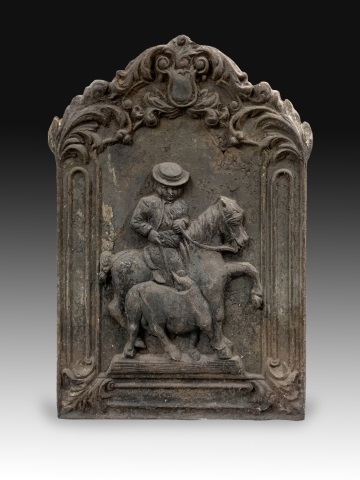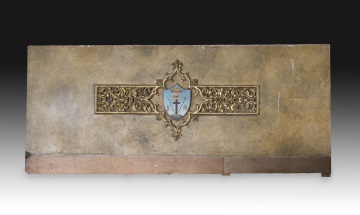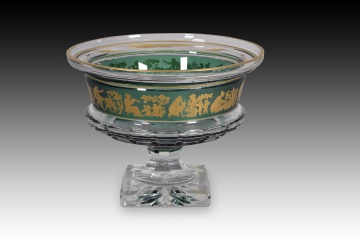
-
Oriental side table. Carved wood, metal. 20th century. Side table made of carved wood, with a rectangular top decorated with two raised panels on the smaller sides and a drawer at the front. Both the shape and the decoration (simple, present on the sides in the form of bands) show a clear influence of Chinese models.
· Size: 97x46x93 cms.
DECORATION
FURNITURE;ORIENTAL
Ref.: XM015
-
Chest. Walnut wood, iron. Spain, 17th century. It has flaws. It requires restoration. Rectangular chest with a flat, protruding lid, made of carved walnut wood and secured by iron pieces at the corners (these finished with a pointed shape cut out of the metal). Despite having only a simple moulding on the lid and the aforementioned elements as the only decorations, these same details link it to pieces made in the Spanish Baroque.
· Size: 105x40x39 cms.
DECORATIVE ANTIQUES
FURNITURE
Ref.: Z0203
-
19th century Pinewood
· Size: 186x45x105 cms.
DECORATIVE ANTIQUES
MISCELLANEUS
Ref.: Z0734
-
Monk's armchair. Leather, walnut wood. Spain, 16th century. It has faults. Armchair with arms and high backrest of the type known as “friar's chair”, which has leather with studs on the upper part of the backrest (lack of the seat), low, low-profile trimmed jambs joining the front and back legs and middle jambs or side rails (the front one carved and re-cut to create geometric motifs) joining the two front and two back legs, and simple armrests with raised scrollwork finishes. The friar's chair, originally of Italian origin, became one of the most common pieces of Spanish furniture since its introduction in the 16th century, being characteristic of both the 17th and 18th centuries and being recovered again in the historicist movement of the 19th century. Being such a deep-rooted tradition in Spain, this type of model was never stopped being created.
· Size: 68x53x102 cms.
ANTIQUES
FURNITURE
Ref.: Z0750
-

Fireplace plate with Picador. Cast iron. Spain, early 20th century. Cast iron fireplace backsplash with a rectangular shape and decorated with reliefs on the front. The upper part features a composition of leaves flanking a plain shield, and is extended along the sides and bottom by a series of lines and more leaves with a classicist influence in the corners. The front shows a figurative bullfighting scene, with a picador (or garrochista or varilarguero) spearing a bull, which charges the horse that the rider is riding. This type of piece was already used in the Gothic period, and outstanding examples have been preserved, such as the one on the Imperial coat of arms of Charles V (dated to the 16th century; Lázaro Galdiano Museum in Madrid), for example. Although some experts consider the heraldry to be the most unusual decoration on these objects, we have also seen pieces with mythological or pastoral scenes, architectural elements, religious motifs, etc. In addition to presenting an interesting decoration due to its historical value in the study of bullfighting, it is worth highlighting the quality and depth of the reliefs it displays.
· Size: 53x74x2,5 cms.
DECORATIVE ANTIQUES
MISCELLANEUS
Ref.: Z3402
-
Centerpiece. Glazed ceramic. Possibly Lunéville (France), 19th century. With marks on the base. Centerpiece with a circular base and oval body decorated on the inside with small bouquets of flowers and on the outside with an elaborate composition based on architectural and plant elements enhanced with touches of color and gold, reminiscent in its movement and curves of Rococo works. 18th century. The “Luneville Faience” factory is one of the main French ceramic manufacturers almost since its foundation in Lunéville (Lorraine, France) in 1730.
· Size: 36x36x18 cms
DECORATIVE ANTIQUES
MISCELLANEUS
Ref.: Z5039
-
Medal. Gilded silver. Spain, 18th century. Devotional medal made of gilded silver showing an image of the Virgin Mary, placed on a pedestal and surrounded by a radiant trilobed halo. Towards the bottom you can see winged angel heads, and note that the back of the piece is worked in the area of the image. Compare with medals of the Virgin of the Tabernacle of Toledo, with the image of the Virgin of the Angels of Getafe, etc. Weight: 40 grams.
· Size: 4,5x0.5x7 cms.
DECORATIVE ANTIQUES
MISCELLANEUS
Ref.: Z5233
-
Chest of drawers. Carved pine wood, wrought iron handles. 20th century. Chest of drawers with a straight rectangular top protruding from the shorter sides and decorated on its fronts with simple rectangular compositions. The three drawers on the front have metal fittings decorated with pearls and pine cones. Stylistically, it is inspired by Renaissance models.
· Size: 46x160x89 cms.
DECORATIVE ANTIQUES
FURNITURE
Ref.: ZE150
-
Sold

Altarpiece or antipendium, coat of arms of the Congregation of the Most Holy Redeemer. Plaster or stucco. 19th-20th centuries. Altar frontal made of plaster or stucco, with a stone-like finish, except for the centerpiece. This rectangular band features a gold finish and fine relief with leaves clearly reminiscent of the Gothic style. In the center, there is a square with lobes on the inside and plant details on the outside; this square houses a polychrome shield. The coat of arms used by the Congregation of the Most Holy Redeemer (Redemptorists) is a derivation of its seal, defined in its statutes of 1764. On a blue background are three mountains, with the cross flanked by a lance and a sponge on a stick, and the abbreviated names of Jesus (IS intertwined) and Mary (AM intertwined); above the Latin cross, an eye with luminous rays; above all these elements, an open crown. This Congregation was founded in 1732 by Saint Alphonsus Maria de Liguori in Scala (Italy) and approved by the Vatican in 1749. In Madrid, the construction of the Parish of the Shrine of Perpetual Help in the Neo-Gothic style by the architect and Redemptorist brother Gusttave Knockaert was of great importance (thus, Neo-Gothic being the most common style in the Congregation especially during the second half of the 19th century). .
· Size: Dec central: 120x5x59 cms.
DECORATIVE ANTIQUES
MISCELLANEUS
Ref.: Z0165B
-
Collection of engravings. “Goya’s Bullfighting”. Special edition directed by Antonio de Horna. 1815-1983. Madrid, Culture and Art Collection, De Horna Editores. 39 sheets. Antonio de Horna directed this compilation of the series of engravings of La Tauromaquia by Francisco de Goya (1746-1828), composed of 39 engravings and published for the first time in 1816, together with another eleven prints called “unpublished” because they did not appear in that first edition. He apparently wanted to use it to illustrate passages from “Historical Letter on the Origin and Progress of Bullfights in Spain”, a work by Nicolás Fernández de Moratín from 1777, to which he added personal memories and some famous incidents from the painter’s time.
· Size: 49,2 x 34,5 x 5 cm.
DECORATIVE ANTIQUES
MISCELLANEUS
Ref.: Z4179B
-
Wall telephone from Kjøbenhavns Telefon Aktieselskab (KTAS). Scandinavia, late 19th century - early 20th century. Wall-mounted telephone from the company Kjøbenhavns Telefon (later known as Kjøbenhavns Telefon Aktieselskab or KTAS) with rear elements featuring a cover for the dial wheel and space for a telephone directory or similar under the device. An early company was founded in Copenhagen in 1881 (Kjobenhavns By-og Hustelegraf, started in 1879); the Danish branch of the American International Bell Telephone Co. was created in 1880 and is considered the precursor to KTAS, registered in 1884 (two years after it began operations in 1882). ; this company bought the other two mentioned).
· Size: 31x24x76 cms.
DECORATIVE ANTIQUES
MISCELLANEUS
Ref.: ZF0115
-
Chippendale style side table. Mahogany wood. English school, 19th century. A round-topped table with slightly cabriole-shaped legs, finished with ball claws and decorated on the top with fine carvings of plant elements. This is the name given to a style pioneered by Thomas Chippendale that was very well-known and common in English cabinetmaking during the 18th and 19th centuries.
· Size: 100x100x75 cms.
DECORATIVE ANTIQUES
FURNITURE
Ref.: ZF0890
-
Mortar and pestle. Bronze. 17th century. Mortar with a circular base, cylindrical body and mouth slightly flared outwards, decorated with a series of smooth horizontal mouldings arranged both at the bottom and at the top and with some simple vertical elements (which still maintain slight balustrade shapes) derived from the ribs that these specimens used to have in the medieval Spanish school.
· Size: 13x13x8,5 cms
ANTIQUES
MISCELLANEUS;MORTARS
Ref.: ZF0966
-
Poseidon or Neptune with a hippocampus. Enameled porcelain. Europe, 19th century. A glazed porcelain figurine with a circular base, decorated with openwork elements and Rococo-inspired motifs enhanced with touches of gold, depicting a bearded, half-naked male figure, standing, in a purple and white cloak, accompanied by a half-horse, half-fish monster. The character is the classical god Poseidon or Neptune, and the creature is known as a hippocampus. This type of work was common in several prominent porcelain factories throughout the 19th century, especially Meissen, but also Chelsea (whose brand name is an anchor) or Samson, for example.
· Size: 6x7x15 cms.
ANTIQUES
MISCELLANEUS;CERAMIC
Ref.: ZF0995
-
Art Nouveau centrepiece. Tin, metal. Victor Saglier, late 19th century. Centrepiece with an oval-shaped metal tray inside, with legs ending in scrolls and an exterior decoration based on plant elements drawing curved lines and undulations, with openwork areas. Stylistically, it responds to Art Nouveau models. Victor Saglier (1809-1894) was a master goldsmith active in Paris (France), highly appreciated for his Art Nouveau style works, creating pieces for Majorelle and Gallé. When he died, the company became Saglier Frères, run from then on by his brothers Eguène and André, until the latter died in 1948.
· Size: 41x21x13 cms
DECORATIVE ANTIQUES
MISCELLANEUS
Ref.: ZF1027
-
Baluster vase. Porcelain. Taisho period, Japan, 1912-1926. With marks on the base. Baluster vase (due to its shape) made of brown glazed Hirado porcelain with iron oxide varnish and two sceptre-shaped handles on top. Hirado is a type of porcelain made mainly in Mikawachi, Sasebo and Nagasaki, in the former feudal territory of Hirado, owner of the kilns and responsible for production. The Taisho period was that under the government of the emperor of the same name, and lasted from July 30, 1912 to December 25, 1926.
· Size: 15x15x27 cms.
ANTIQUES
MISCELLANEUS;CERAMIC
Ref.: ZF1109
-
Angel, archangel, or saint, on a base. Carved and polychrome wood, textile, etc. Spanish School, 17th century. It has defects. A carved, polychrome, and gilded wood sculpture depicting a young male figure dressed in armor reminiscent of Classicism, which also features a jewel (or remnants of it) on his chest. It also features fabrics with a slight movement, where remnants of the gilding that once covered them can be seen. Iconographically, since it does not feature attributes, it is not clearly identifiable, although comparing the postures and the armor could be a carving of Saint Michael the Archangel (note the two hollows in the back, where the wings would have been).
· Size: 20x20x49 cms.
DECORATIVE ANTIQUES
SCULPTURE
Ref.: ZF1468
-
Christ of Burgos. Wood, metal. Spanish school, 19th century. A rectangular base serves as the base for a Latin cross with finials at the three upper ends. This has the usual inscription “INRI” and a particular figure of Christ Crucified, with a very long loincloth and an oval element at his feet. The name Santo Cristo de Burgos refers to an anonymous articulated carving from the 14th century that is found in the Chapel of the Most Holy Christ of Burgos (Burgos Cathedral, Spain) and has been highly appreciated since ancient times. Weight: 750 grams.
· Size: 28x11,5x44 cms
DECORATIVE ANTIQUES
SCULPTURE
Ref.: ZF0376A
-
Sold

Centerpiece, “Flora’s Dance”. Glass. Val-Saint-Lambert, Belgium, 20th century. A glass centrepiece in the shape of a goblet, with a frieze depicting a dance in gold; the creation of this piece is linked to a design by Leon Ledru and also to Metisse. Val Saint Lambert is a glass company that has been in operation since 1826 and has its headquarters in the former Seraing Abbey (Liège, Belgium). In 1825, Jean-François Deneef set up shop in Val Saint-Lambert with the intention of creating a crystal factory that was better than Baccarat's. In fact, it is highly appreciated for the quality of its products, and it has been the quality of its crystal that has earned it several awards.
· Size: 14x14x32 cms.
DECORATIVE ANTIQUES
MISCELLANEUS
Ref.: ZF1132B
-
Silver tray in its colour. Possibly Spain, 20th century. It has damage. Rectangular silver tray with wavy edges and centre and bottom decorated with an embossed composition with a plant theme, arranged around a central protruding rectangle. Stylistically, it is inspired by old Spanish silverware models. Weight: 340 grams.
· Size: 23x2.5x34.5 cms
DECORATIVE ANTIQUES
MISCELLANEUS
Ref.: ZF1146A
-
Sold

Frame. Carved wood. 18th century. It has faults. Rectangular wall frame made of carved wood and decorated with architectural and plant elements reminiscent of Classicism, divided into two wide moldings and two thinner ones (one striped separating the two bands and another interior with two pearls between the long sections). The curves that emerge towards the interior, as well as the hollow in that area, are particularly noteworthy.
· Size: 58x6,5x49 cms. int: 40,5x31 cms.
ANTIQUES
MISCELLANEUS;FRAMES
Ref.: ZF1340A
-
Devotional plaque, Saint Anthony of Padua. Bronze. Spanish School, 17th century. Rectangular bronze devotional plaque with a ring at the top, a molded frame, and a relief figurative representation on the front. It shows a man in a habit, standing, holding a book in one hand (on which the Child Jesus can be seen) and a cross in the other, resting on his shoulder. Two pedestals are featured, one with a skull and the other with books. Compare with the one in the Metropolitan Museum (inventory 2012.545.12), dated to the early 17th century. Weight: 146 grams.
· Size: 7,1 x 0,5 x 11,4 cm
ANTIQUES
MISCELLANEUS;OTHER OBJECTS
Ref.: ZF1416N
-
Devotional plaque, Saint Benedict of Nursia. Bronze. Spanish School, 17th century. Rectangular bronze devotional plaque with a ring at the top, a molded frame, and a relief figurative representation on the front. It shows a man in a habit, standing, holding a staff and a book in one hand, with a sunburst or burst of glory in the upper left corner, and a book and a miter in the lower area. This is Saint Benedict of Nursia, a Christian monk, considered the founder of monastic life in the West and venerated as a saint by the Catholic Church, the Orthodox Church, and the Lutheran Church. Weight: 130 grams.
· Size: 7 x 0,4 x 11 cm.
ANTIQUES
MISCELLANEUS;OTHER OBJECTS
Ref.: ZF1416Q
-
Devotional plaque, Immaculate Conception. Bronze. Spanish School, 17th century. Bronze devotional plaque with a washer at the top and an oval shape featuring a relief on the front. It depicts the Virgin Mary on a crescent moon, surrounded by light, clasping her hands in prayer, and with the Franciscan cord (eight knots) around it, linking this medal to the Franciscan Order. Four winged angel heads appear in the corners. This iconography and representation are common on devotional plaques and medals since the Baroque period (similar examples are preserved in institutions such as the Lázaro Galdiano Museum, etc.). Weight: 122 grams.
· Size: 7,5 x 0,4 x 11,7 cm
ANTIQUES
MISCELLANEUS;OTHER OBJECTS
Ref.: ZF1416T